Text






10th century church door with Norse ironwork at St. Helen’s Church in Stillingfleet, England
5K notes
·
View notes
Text
Thread on alternative views of iconic landmarks you (probably) haven’t seen before 🧵
1. Mount Fuji from a plane window.
2. Arc de Triomphe, Paris

3. Aerial view of Kaaba, Mecca

4. A view of the Taj Mahal that you do not usually see, highlighting the stark contrast between opulence and poverty divided by a single wall.

5. Top down view of the Statue of Liberty

6. The backside of Tutankhamun's burial mask

7. The dome of St. Peter’s Basilica seen through Rome's most famous keyhole.

8. The worn steps of the Tower of Pisa

9. Photographer Alexander Ladanivskyy, in collaboration with the Egyptian Ministry of Tourism, captured an extraordinary drone shot of the Great Pyramid of Giza from an unusual perspective.

10. The Shanhai Pass, where the Great Wall of China meets the ocean.

for images 11 - 25, please see the source, here
28K notes
·
View notes
Text
Thread on alternative views of iconic landmarks you (probably) haven’t seen before 🧵
1. Mount Fuji from a plane window.
2. Arc de Triomphe, Paris

3. Aerial view of Kaaba, Mecca

4. A view of the Taj Mahal that you do not usually see, highlighting the stark contrast between opulence and poverty divided by a single wall.

5. Top down view of the Statue of Liberty

6. The backside of Tutankhamun's burial mask

7. The dome of St. Peter’s Basilica seen through Rome's most famous keyhole.

8. The worn steps of the Tower of Pisa

9. Photographer Alexander Ladanivskyy, in collaboration with the Egyptian Ministry of Tourism, captured an extraordinary drone shot of the Great Pyramid of Giza from an unusual perspective.

10. The Shanhai Pass, where the Great Wall of China meets the ocean.

for images 11 - 25, please see the source, here
28K notes
·
View notes
Text
The importance of dandelion: best secrets

The importance of dandelion, the first volume of category Herbs. We go into depth with its characteristics and benefits.
Why we should consider dandelionin our lifestyle?
Let's start with the characteristics. We will proceed in this way.
Scientific name
Growth
Nutrients
Symbolism
Properties
Metabolism
Uses
Scientific name
The scientific name of the dandelion is Taraxacum officinale.
There is naturally an explanation for the various names of the plant: it is called "dandelion" due to the jagged shape of its leaves, "blowball" because of the fluffy ball that contains the seeds. The official name Taraxacum comes from the Greek ταραχή tarakhḕ "disturbance", and ἄκος àkos "remedy", which indicates its ability to restore the organism to order. Finally, there is one last name by which the dandelion is known, "piss-a-bed", given for its diuretic properties.
https://it.wikipedia.org/wiki/Taraxacum_officinale
Growth: understanding the evolution
Dandelions are resilient plants that thrive in a variety of environments. They typically grow in disturbed soils, such as gardens, lawns, and fields. The growth pattern of dandelions can be outlined as follows:
Seed germination: nature's resilient warriors, create life through their exquisite seeds, carried gracefully by the whims of the wind. Each delicate, fluffy seed embarks on an adventurous journey, destined to land and thrive in the nurturing embrace of fertile soil, where it transforms into a vibrant symbol of nature’s unstoppable spirit.
Taproot formation: once a seed germinates, it develops a deep taproot that can reach up to 10 inches (25 cm) into the ground. This root helps the plant access nutrients and water, allowing it to survive harsh conditions.
Leaf growth: dandelion leaves grow in a rosette pattern close to the ground. The leaves are serrated and can grow up to 12 inches (30 cm) long. They are vital for photosynthesis, enabling the plant to convert sunlight into energy.
Flowering: dandelions typically bloom in spring and can continue to flower into the fall. Each flower head consists of numerous tiny yellow florets and can attract various pollinators, including bees.
Seed production: after flowering, the dandelion forms a seed head that transforms into a round, white, fluffy structure. Each flower can produce up to 200 seeds, which are then dispersed by the wind to germinate elsewhere.
This adaptive growth strategy allows dandelions to flourish in diverse conditions, contributing to their reputation as a hardy and persistent plant.
Nutrients
Now, we are going to go into depth talking about the nutrients and properties of dandelion.
About nutrients, dandelion includes substances like vitamins A, C, and K, along with essential minerals such as iron, calcium, and potassium, making it a highly nutritious plant beneficial for overall health. Vitamin C is known for its antioxidant properties, whereas vitamin K for helping blood coagulation and circulation.
Symbolism
The dandelion is a powerful symbol of resilience and hope; its ability to thrive in various environments represents perseverance in adversity. Each fluffy seed head signifies wishes and dreams, as children and adults alike blow the seeds into the wind, sending their aspirations into the universe. Additionally, the plant's transformation from a bright yellow flower to a white puffball illustrates the cycle of life, transformation, and the beauty of change. Beyond personal meanings, dandelions embody the concept of freedom, as their seeds spread effortlessly across vast distances, reminding us of the power of liberation and the potential for new beginnings.
Once I told you the first point of this fascinating plant, now it's time to know the properties.
Properties
Dandelions can have a positive effect on metabolism through several natural properties:
Digestive support: dandelion stimulates appetite and increases bile production, which aids in digestion and the efficient breakdown of fats — a key aspect of metabolism.
Liver detoxification: the liver plays a central role in metabolism. Dandelion root is known to support liver function, which can enhance the body’s ability to metabolize nutrients and detoxify waste.
Diuretic action: dandelion acts as a natural diuretic, helping the body eliminate excess fluid and toxins, which may indirectly support metabolic balance.
Blood sugar regulation: some studies suggest that dandelion may help regulate blood sugar and insulin levels, which is important for maintaining metabolic health.
Rich in antioxidants: dandelions contain polyphenols and flavonoids that reduce oxidative stress, which can otherwise impair metabolism.
Inulin content: dandelion root contains inulin, a prebiotic fiber that supports gut health — essential for proper nutrient absorption and metabolic processes. You can know more in How to improve gut microbiota in 5 ways.
In summary, dandelions support metabolism by promoting liver function, digestive health, detoxification, and glucose control. Would you like sources or herbal preparation methods for metabolism support?
The importance of dandelion: metabolism
Dandelions may help support healthy glycemia (blood sugar levels) through several natural mechanisms:
Some studies suggest that these compounds may help improve how cells respond to insulin, making it easier for the body to regulate blood sugar.
Dandelion root contains inulin, a prebiotic fiber that slows glucose absorption in the gut, reducing blood sugar spikes after meals.
The antioxidants in dandelion—like chlorogenic acid and polyphenols—can reduce oxidative stress, which is linked to insulin resistance and type 2 diabetes. Also read about Resveratrol: a molecule with thousand of resources to discover the powerful effects of poliphenols.
Chronic inflammation can interfere with insulin activity. Dandelion has anti-inflammatory compounds that may help improve glucose metabolism.
Some lab studies have shown that the plant may inhibit enzymes like alpha-amylase and alpha-glucosidase, which are responsible for breaking down carbs into sugar—similar to how some diabetes medications work.
Caution to consider: personal counseling
Interaction with diabetes medications and diuretics. So this is an aspect to discuss about.
Always consult a healthcare provider before using it regularly for glycemic control.
Recipe to prepare the perfect dandelion tea for your organism

Here are 3 effective ways to prepare dandelion to support blood sugar control:
Dandelion Root Tea (Best for inulin and liver support)
Ingredients:
1–2 teaspoons of dried dandelion root (roasted or raw)
1 cup of hot water
Instructions:
Place the dandelion root in a teapot or cup.
Pour boiling water over it.
Steep for 10–15 minutes.
Strain and drink 1–2 times daily.
Benefit: rich in inulin, supports digestion, blood sugar stability, and liver detox.
Dandelion Leaf Tea or Salad (Best for diuretic effect and antioxidant support)
For tea:
Use 1 teaspoon dried or 1 tablespoon fresh leaves
Steep in hot water for 5–10 minutes
For salad:
Wash fresh young leaves
Add to salads with lemon juice or vinegar (helps blood sugar too)
Benefit: high in potassium and antioxidants; supports insulin sensitivity.
Dandelion Root Tincture (More concentrated)
Use:
1–2 dropperfuls (around 30–60 drops) in water, 1–3 times a day before meals
Note: buy from a trusted herbalist or make it by steeping chopped root in vodka for 4–6 weeks.
Benefit: a strong, convenient way to get daily therapeutic doses.
Tips:
Start with small doses to check for reactions.
Combine with a low-sugar diet and exercise for best results.
Always consult a healthcare provider if you're on diabetes medication.
Source: The importance of dandelion: best secrets
129 notes
·
View notes
Text
This week's #RainsfordDay book is this alchemical compendium, written in English in the late 18th century, which includes instructions for alchemical processes such as transmutation, sublimation, and multiplication, with practical applications such as embalming bodies. It was copied by Charles Rainsford himself. Rainsford was an 18th century British army officer, fellow of the Royal Society, and alchemist, who collected (and copied) books about his interests. (UPenn Ms. Codex 1690)
🔗:
55 notes
·
View notes
Text


5,500-Year-Old Sumerian Star Map“For over 150 years scientists have tried to solve the mystery of a controversial cuneiform clay tablet that indicates the so-called Köfel’s impact event was observed in ancient times. The circular stone-cast tablet was recovered from the 650 BC underground library of King Ashurbanipal in Nineveh, Iraq in the late 19th century. Long thought to be an Assyrian tablet, computer analysis has matched it with the sky above Mesopotamia in 3300 BC and proves it to be of much more ancient Sumerian origin. The tablet is an “Astrolabe,” the earliest known astronomical instrument. It consists of a segmented, disk-shaped star chart with marked units of angle measure inscribed upon the rim.
4K notes
·
View notes
Text





elaborate manicules
from the margins of an illustrated manuscript of le roman de renart. northern france, 14th c.
source: Paris, BnF, Français 12584
2K notes
·
View notes
Text
Presented for your consideration: a manuscript collection of texts of hymns (written in Germany at the end of the 15th c.) and prayers bound with slightly later printed pastoral works appropriate for a priest (printed in Augsburg in 1519). Not unusual to see such hybrid books in the 15th and 16th centuries, but always interesting. (Ms. Codex 1604)
🔗:
219 notes
·
View notes
Text
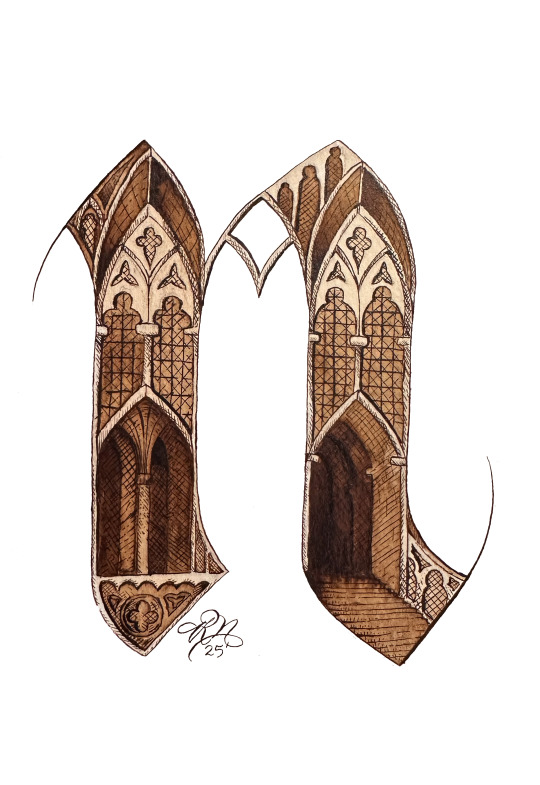

2024 brought many welcomed changes and lots of growth for me and I'm bringing that energy to 2025. These are the first prints I'm selling! The first is part of a series of Gothicized Italic letters composed of gothic architecture starting with a minuscule n. The second print is a quote by Alphonse De Lamartine. Both were penned in walnut ink. Print are for sale on my site! https://www.rachael-otf.com/store
15 notes
·
View notes
Text
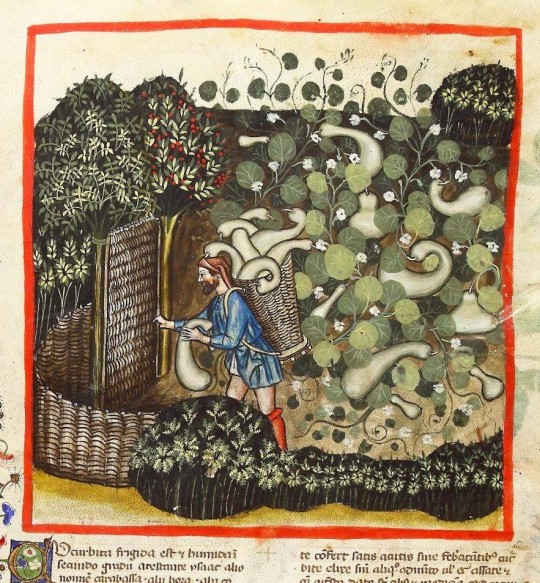
gourd harvest
miniature from a medical manuscript (tractatus de herbis), illuminated by giovannino de' grassi and his workshop. milan, late 14th c.
source: Rome, Biblioteca Casanatense, Cod. Lat. 459, fol. 83r (via Bibliotheca Corvina)
831 notes
·
View notes
Video
youtube
Domus Aurea: The Illustrious Palace of Emperor Nero I SLICE HISTORY
18 notes
·
View notes
Text
Pompeii. New discoveries








A bird of prey stands out in the upper part of the lararium. The raptor, which can probably be identified as an eagle, holds a palm branch in its claws. In the lower part, the scene consists of two snakes facing each other which frame an altar with a fluted circular shaft on which offerings are placed. From the left, it is possible to distinguish the following features: a pine cone, a raised element that supports an egg, and what appear to be a fig and a date. The background of the scene is filled with two bushes with lanceolate leaves and red and yellow berries on which three sparrows move about. Several interesting finds were discovered inside the niche: ritual objects, left as part of a last offering before the eruption that destroyed Pompeii in AD 79: an incense burner in achromatic clay with missing pieces dating from antiquity and a lamp, both displaying clear signs of burning. Laboratory analyses have made it possible to identify the remains of twigs of aromatic plants, while two parts of a dried fig were found behind the two objects. Two strips of coloured marble were discovered on the flat top of the altar together with a third element, presumably made of red marble, with the depiction of a face ascribable to the Dionysian world, probably a Silenus.
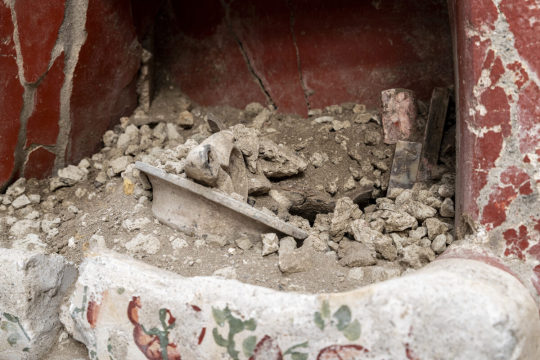

Text from the article by pompeiisites.org (October 2024) Photos provided by pompeiisites.org
3K notes
·
View notes
Text


Anatomical illustration of the female body with mapping of the demons which rule each body part and related affections (unknown author, 18th-19th century)
From: Archivio di Stato di Modena (digitalized version on Lodovico Media Library)
472 notes
·
View notes
Text
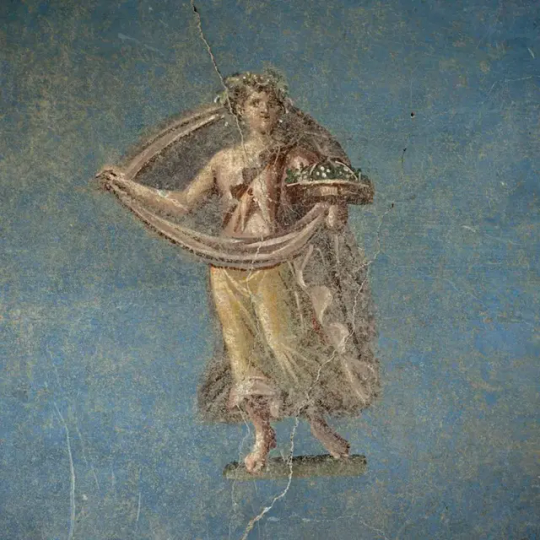




'Once-in-a-Century' Discovery Reveals Luxury Bathhouse in Pompeii
After lying hidden beneath metres of volcanic rock and ash for 2,000 years, a "once-in-a-century" find has been unearthed in the ancient Roman city of Pompeii in Italy.
Archaeologists have discovered a sumptuous private bathhouse - potentially the largest ever found there - complete with hot, warm and cold rooms, exquisite artwork, and a huge plunge pool.
The spa-like complex sits at the heart of a grand residence uncovered over the last two years during a major excavation.
"It's these spaces that really are part of the 'Pompeii effect' - it's almost as if the people had only left a minute ago," says Dr Gabriel Zuchtriegel, director of the Archaeological Park of Pompeii.

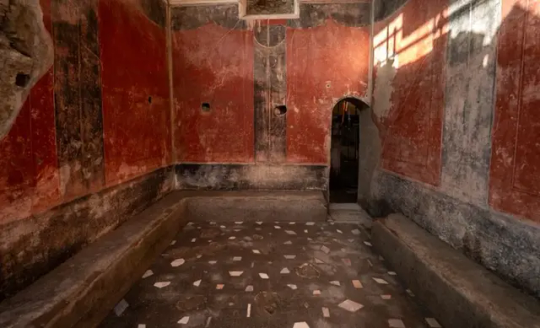
The bathhouse changing room has vibrant red walls, a mosaic floor and stone benches
Analysis of two skeletons discovered in the house also shows the horror faced by Pompeii's inhabitants when Mount Vesuvius erupted in AD79.
The bodies belonged to a woman, aged between 35 and 50, who was clutching jewellery and coins, and a younger man in his teens or early 20s.
They had barricaded themselves into a small room, but were killed as a tsunami of superheated volcanic gas and ash - known as a pyroclastic flow - ripped through the town.
"This is a dramatic place, and everything you find here tells you about the drama," says Pompeii conservator, Dr Ludovica Alesse.
A third of the ancient city still lies hidden beneath volcanic debris from the disaster, but the new excavation - the most extensive in a generation - provides new insights into ancient Roman life.
The archaeologists have been followed by a documentary team from the BBC and Lion TV, for a series called Pompeii: The New Dig.


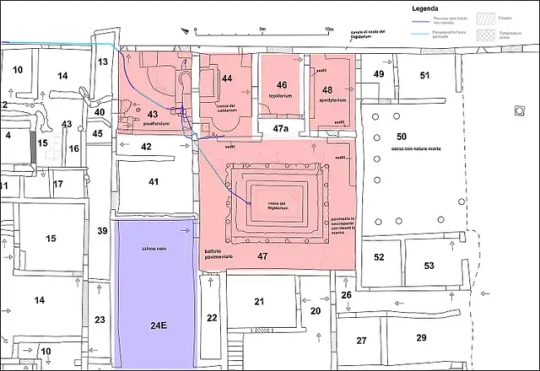

An entire block of Pompeii has now been uncovered, revealing a laundry and bakery, as well as the large private house. It's thought these were all owned by one wealthy individual, possibly Aulus Rustius Verus, an influential Pompeii politician.
The discovery of the bathhouse is further confirmation of his elite status, says Dr Zuchtriegel.
"There are just a few houses that have a private bath complex, so it was something really for the wealthiest of the wealthy," he says. "And this is so huge - it's probably the biggest bath complex in a Pompeiian private home."Those lucky enough to use the suite of bathing rooms would have undressed in a changing room with vibrant red walls and a mosaic floor dotted with geometric patterns inlaid with marble from across the Roman Empire.

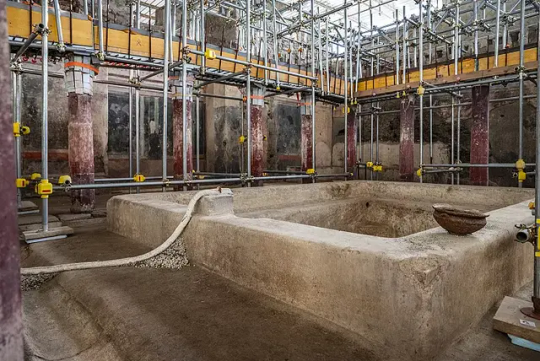
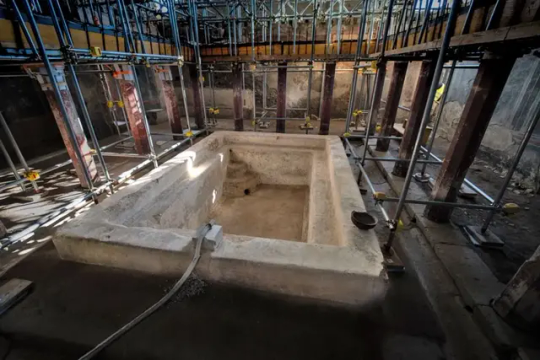
Twenty to 30 people could bathe in the cold room's plunge pool, which is more than 1m deep
They would then head to the hot room, taking a dip in a bath and enjoying the sauna-like warmth, provided by a suspended floor that allowed hot air to flow underneath and walls with a cavity where the heat could circulate.
Next they would move to the brightly-painted warm room, where oil would be rubbed into the skin, before being scraped off with a curved instrument called a strigil.
Finally, they would enter the largest and most spectacular room of all - the frigidarium, or cold room. Surrounded by red columns and frescoes of athletes, a visitor could cool off in the plunge pool, which is so large 20-30 people could fit in it.
"In the hot summers, you could sit with your feet in the water, chatting with your friends, maybe enjoying a cup of wine," says Dr Zuchtriegel.
The bathhouse is the latest find to emerge from this extraordinary house.
A huge banqueting room with jet black walls and breathtaking artwork of classical scenes was found last year. A smaller, more intimate room - painted in pale blue - where residents of the house would go and pray to the gods was also unearthed.
The residence was mid-renovation - tools and building materials have been found throughout. In the blue room a pile of oyster shells lie on the floor, ready to be ground up and applied to the walls to give them an iridescent shimmer.


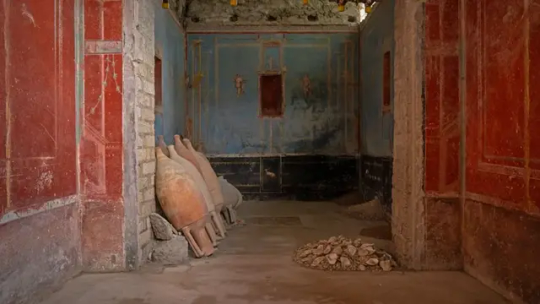
A small blue room used for prayer. Amphoras - terracotta containers used to transport olive oil or wine - are resting against a wall. Oyster shells are piled on the floor
Next door to this beautiful space, in a cramped room with barely any decoration, a stark discovery was made - the remains of two Pompeiians who failed to escape from the eruption.
The skeleton of a woman was found lying on top of a bed, curled up in a foetal position. The body of a man was in the corner of this small room.
"The pyroclastic flow from Vesuvius came along the street just outside this room, and caused a wall to collapse, and that had basically crushed him to death," explains Dr Sophie Hay, an archaeologist at Pompeii.
"The woman was still alive while he was dying - imagine the trauma - and then this room filled with the rest of the pyroclastic flow, and that's how she died."

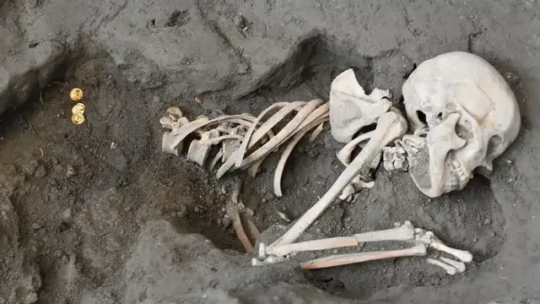
The skeleton of a woman, clutching coins, was found curled in a foetal position
Analysis of the male skeleton showed that despite his young age, his bones had signs of wear and tear, suggesting he was of lower status, possibly even a slave.
The woman was older, but her bones and teeth were in good condition.
"She was probably someone higher up in society," says Dr Hay. "She could have been the wife of the owner of the house - or maybe an assistant looking after the wife, we just don't know."
An assortment of items were found on a marble table top in the room - glassware, bronze jugs and pottery - perhaps brought into the room where the pair had tucked themselves away hoping to wait out the eruption.
But it's the items clutched by the victims that are of particular interest. The younger man held some keys, while the older woman was found with gold and silver coins and jewellery.
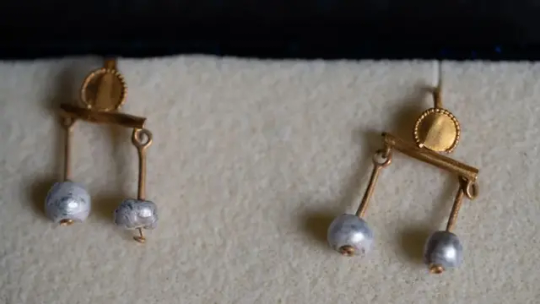
A pair of gold and natural pearl earrings found close to the female skeleton
These are kept in Pompeii's vault, along with the city's other priceless finds, and we were given a chance to see them with archaeologist, Dr Alessandro Russo.
The gold coins still gleam as if they were new, and he shows us delicate gold and natural pearl earrings, necklace pendants and intricately etched semi-precious stones.
"When we find this kind of object, the distance from ancient times and modern times disappears," Dr Russo says, "and we can touch a small piece of the life of these people who died in the eruption."

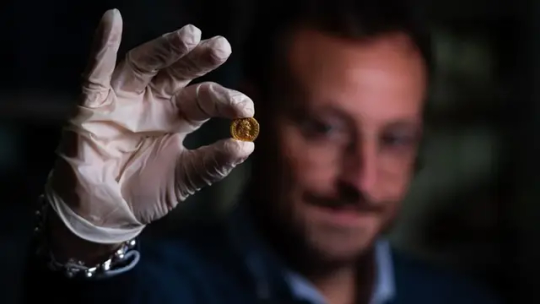
Archaeologist Alessandro Russo holds a gold coin found with the female skeleton
Dr Sophie Hay describes the private bathhouse complex as a once-in-a-century discovery, which also sheds more light on a darker side of Roman life.
Just behind the hot room is a boiler room. A pipe brought water in from the street - with some syphoned off into the cold plunge pool - and the rest was heated in a lead boiler destined for the hot room. The valves that regulated the flow look so modern it's as if you could turn them on and off even today.
With a furnace sitting beneath, the conditions in this room would have been unbearably hot for the slaves who had to keep the whole system going.
"The most powerful thing from these excavations is that stark contrast between the lives of the slaves and the very, very rich. And here we see it," says Dr Sophie Hay.
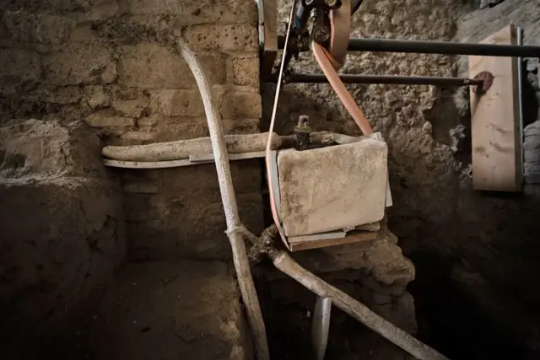
Pipework and taps in the residence's boiler room
"The difference between the sumptuous life of the bathhouse, compared to the furnace room, where the slaves would be feeding the fire toiling all day.
"A wall is all that could divide you between two different worlds."
The excavation is in its final weeks - but new discoveries continue to emerge from the ash. Limited numbers of visitors are allowed to visit the dig while it's ongoing, but eventually it will be fully opened to the public.
"Every day here is a surprise," says Dr Anna Onesti, director of the excavation.
"Sometimes in the morning I come to work thinking that it's a normal working day - and then I discover we found something exceptional.
"It's a magic moment for the life of Pompeii, and this excavation work offers us the possibility to share this with the public."
By Rebecca Morelle and Alison Francis.
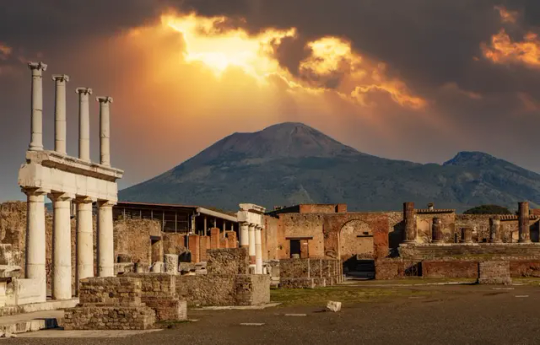

185 notes
·
View notes


